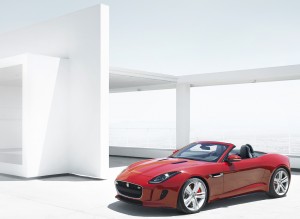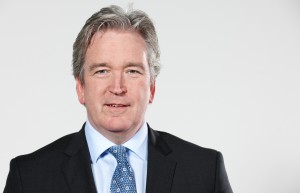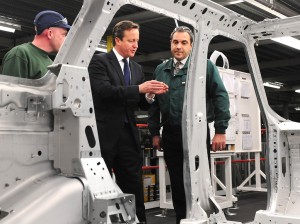There’s plenty of good news for Jaguar Land Rover these days. Like most of the industry, sales are up. A raft of products and technologies are expected in the next few years, which should lead to even bigger sales increases. And its Indian owners are allowing the brands to spend the money to develop its new products.
It’s been almost five years since Tata Motors purchased JLR from Ford, effectively putting an end to Ford’s much publicized Premier Automotive Group.
Adrian Hallmark, global brand director and a member of the JLR executive committee, told TheDetroitBureau.com in an exclusive interview that the automaker is in good shape to fulfill its aggressive goals.
Hallmark said Land Rover will launch its first hybrid in the Range Rover later this year. He said the system was designed in-house with the help of suppliers.
But the company is working on two other hybrid systems for different-sized vehicles.
“We see a place for (hybrids) in the market,” Hallmark said. “Customers aren’t screaming for them.”
But government regulators are. Fuel economy regulations are the primary reason why JLR will offer the hybrid systems. Diesels – for both Land Rover and Jaguar – are coming as well, he added.
Hallmark said JLR has been profitable, but Tata is allowing the company to roll some of profits back into development of new products.
“They’re encouraging and allowing us to put that back into the business,” Hallmark said.
With sales of just more than 350,000 in 2012, Hallmark said there is plenty of room for growth, even if the company won’t likely take on major luxury makers such as Mercedes-Benz and BMW. The company is projecting a 45% sales increase in the next five years.
But he said the company has 40 new products and technologies headed for production in the next five years.
An electric vehicle is not amongst those vehicles planned for the next five years. Hallmark said the company has a long-lead team working on technologies that are more than five years away.
“We will have (an EV), but it’s not a priority right now,” Hallmark said.
Like most of world’s automakers, JLR saw sales jump significantly in 2012, rising 30%, led by Land Rover, which was up 36 percent.
“Obviously, a big impact to that number was the Land Rover Evoque,” Group Sales Operations Director Phil Popham said.
JLR sold 357,713 units worldwide for the year.
In fact, the year could have been even better as the company left sales on the table in China – where it saw a 71% increase in sales – because it ran out of 3.0-liter engines.
But the competition is only increasing. There has been a 73 percent increase in nameplates among SUVs with another 35 percent coming by 2018. And production expansion in the premium segment is up 45%.
But despite all of that, JLR thinks it has an opportunity to make an impact in the luxury car and SUV segments because of the historic resonance of its brands and the resources the company is committing to future projects. With eight significant projects – including new powertrains and vehicles – expected in the next year, the company is investing $2.7 billion, making the company the largest investor in technology in the United Kingdom. Already, the company has invested in what it calls the world’s largest aluminum body shop in its Solihull plant, the primary production facility for Land Rover.
The company is particularly excited about the new F-Type, which will open up a completely new market for Jaguar.
“It marks the re-entry of Jaguar into the sports car market,” Popham said.
In fact, Rob Filipovic, general manager of Jaguar product planning at Jaguar Land Rover, said the F-Type is bringing a new group of potential buyers to the company. Eighty-five percent of the 25,000 people who have shown interest in the car are new to the brand.
“It’s not like anything we have on the road today,” Filipovic said.
The company is also planning to begin production of the Freelander in India.
“We’re looking at other opportunities around the world where appropriate to build vehicles,” he said.
JLR now has 23 training academies and will add 10 more, along with five new parts distribution centers. It’s added 121 new dealers. Employment rose by 8,000 people in 2011 and 2012, raising total employment to 25,000.
Kim McCullough, brand vice president for Land Rover, said remaking its iconic Range Rover was a huge task for the company, one wrought with potential pitfalls. Longtime Range Rover owners were quick to share their opinions.
“They said make it better, but keep it a Range Rover,” McCullough said.
“Some of these folks aren’t going to go boulder hopping, but they want to know that they can,” she said.




All car makers will be forced to sell hybrids, EVs and probably motorized bicycles – to meet the outrageous 54.5 mpg CAFE standards that the ignorant folks at the EPA picked for a number, which had to be pulled from their arse, because no car maker can deliver a fleet of automobile models that deliver CAFE 54.5 mpg.
Hi, Jorge,
Let’s note that 54.5 mpg CAFE is not the same as 54.5 mpg on your average car’s Munroney sticker. There are all sorts of ways to get credits that add tenths and even a number of miles, to the score for a maker’s individual products. The industry will blow through the 37.1 mpg standard for 2016, it appears, a figure nobody thought it could come close to meeting just a few years ago, much like they made 27.5 mph and every target previously. Now, that said, 54.5 is a major jump and not going to be easy. But I am not ready to panic yet.
Paul A. Eisenstein
Publisher, TheDetroitBureau.com